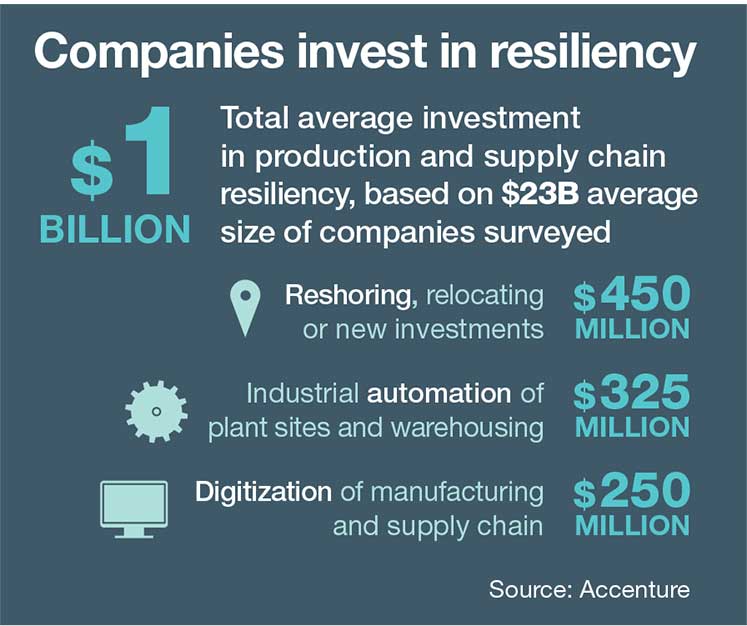Getting ahead of the next supply and production disruption
New research shows which emerging capabilities help supply chain executives make their businesses more resilient.
Most companies today have globalized industrial value chains, with free-flowing movement of goods and services that serve every customer globally. Local sourcing is limited and plant specialization remains the order of the day, with one plant in one location mass-producing one specific product.
However, the turbulence of the last few years has shown just how vulnerable these highly globalized supply and production networks are. Now many businesses are rethinking this set-up—and regionalization strategies are high on their list.
Regionalization strategies are trending

According to a recent Accenture survey, 65% of companies intend to buy most key items from regional suppliers by 2026, up from 38% today. Even more organizations (85%) plan to produce and sell most of their products in the same region by 2026, almost doubling from 43%. The survey was part of a research project in which Accenture analyzed what really made supply and production networks resilient.
We define resiliency as a company’s ability to sense, absorb, adapt to and recover from a force of change that disrupts their engineering, supply chain, production and operations functions. Examples of these forces are inflationary pressures, fluctuating energy prices, material shortages, talent scarcity, and even technological breakthroughs like Generative AI.
Emerging resiliency capabilities that pay off
According to our findings, companies indeed tend to be less vulnerable if they have a more local supply base and transportation flow.
However, what separates the wheat from the chaff is having command of a set of emerging capabilities. We were able to link maturity in these “Resiliency 2.0 capabilities” directly to hard financial and performance data.
- The companies performing highest in these areas achieved 3.6% higher annual revenues in the past two years.
- At the same time, their product order-to-delivery lead times increased by 40%.
- Immature companies, on the other hand, need up 152 days to recover from disruptive events—119 days more than the most mature organizations. The contrast couldn’t be stronger.
Resiliency 2.0 capabilities fall into the following categories.
- Demand foresight. Emerging capabilities in this category help companies anticipate and predict changes in demand and customer needs, as well as greater societal and cultural shifts. They include structured analytics tools to predict surge or decline in demand (in addition to customer historical forecasts) and proactive customer segmentation to arbitrate demand in case of shortage.
- Smart end-to-end control towers. In order for these so-called visibility solutions to anticipate and identify risks, and analyze causation throughout the value chain, they need dynamic and data-driven planning with “what-if” scenario capabilities. They must also be able to predict operations issues early, such as poor quality, breakdowns and maintenance needs.
- Autonomous production. This means hyper- flexible and automated production lines tailored for high customization or ability to quickly reconfigure to change. This capability is critical to having an industrial system capable of quickly and seamlessly reconfiguring and correcting.
- Dynamic and sustainable product development. Resiliency benefits from being able to embed sustainability by design in new products and processes. Companies should design them in a co-engineering approach that involves engineering, product R&D, design, operations, marketing, cybersecurity and sustainability teams, suppliers and customers. This collaboration should include digital twin platforms. Offerings should be upgraded continuously to adapt to customer needs, for example, by providing services upgrades and features upgrades over the air.
- Agile organization. Emerging resiliency capabilities include decentralized decision making close to execution, with transparency at all levels, and remote expertise capabilities through, for example, augmented reality and virtual reality.
- Flexible workforce. Resiliency increases when companies have highly versatile, adaptable and diverse workers and a culture of continuous learning. Workers need to know how to use predictive and visualization tools and make decisions based on data. These complexities are not easily solved by siloed functional teams. They require employees who are comfortable working with data and AI tools and solutions, and can do so across operations.
Redesigning supply and production for sustained resiliency
Many companies applied short-term fixes to their complex global production and supply networks in recent years. These networks had been designed for just-in-time deliveries and to be as cost-efficient as possible. Now is the time to strategically redesign them for sustained resiliency—and sustainability.
As determination to go “net zero” grows across society and governments, reducing emissions becomes a building block of resilience. When companies redesign their supply chain and production networks, they must do so with this goal in mind.
For example: Up to 80% of a company’s upstream emissions come from Tier 2-plus suppliers. However, most businesses today are unable to detect and track which supplier emits how much.
One central action companies should take is integrating emissions into their supply chain control tower—and complement the control tower with a digital twin of the supply chain. This virtual replica not only maps physical material flows and uncovers sub-tier suppliers and risks, but can also simulate the carbon footprint of the entire network.
This example shows how the rapid innovation in data, AI and other technologies provides ample opportunity for businesses to build Resiliency 2.0 capabilities. Companies that invest in their digital maturity will be best positioned to get ahead of disruption.











